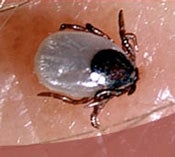 KINGSTON, R.I. – June 24, 2009 – Not quite half way through the worst of the 2009 tick season, and deer tick abundance in Rhode Island is running 54 percent higher this year compared to the same time last year, according to preliminary results from the University of Rhode Island’s statewide Tick Encounter Risk Survey.
KINGSTON, R.I. – June 24, 2009 – Not quite half way through the worst of the 2009 tick season, and deer tick abundance in Rhode Island is running 54 percent higher this year compared to the same time last year, according to preliminary results from the University of Rhode Island’s statewide Tick Encounter Risk Survey.
So far, the first of two planned samples have been collected at 37 of 61 sites around the state. Deer ticks transmit Lyme disease, babesiosis and anaplasmosis.
Thomas Mather, professor of entomology and director of URI’s Center for Vector Borne Disease, said that the survey of tick populations has found greater tick numbers than last year at 26 sites and fewer ticks at 10 sites. At one site, tick numbers remained the same.
“Certain regions always seem to stand out for their growth in tick abundance,” Mather said. “In 2007 it was the East Bay that saw the greatest increase, and numbers there have remained high ever since. This year it’s northern Rhode Island that is experiencing the most impressive gains.”
A site in Cumberland, for example, increased by 4,100 percent over 2008. Just one tick was found there last year, while 42 were collected there this year. One of two sites in Smithfield saw a 2,200 percent increase, from one tick last year to 23 this year. Tick numbers at a survey site in Burrillville increased by 250 percent this year.
“When we started our survey in 1993, there were no ticks found at a third of our sites, but over time deer ticks have reached all of our sites,” said Mather. “The Cumberland site was our last holdout – we found our first deer tick there in 2006 – and now tick abundance is climbing dramatically.”
“While the numbers are still relatively small in northern Rhode Island compared to those found in South County, the gains are still impressive,” Mather added.
Mather noted that the weather this spring has been perfect for tick survival – “these deer ticks love high humidity and moisture,” he said – which means that the nymphal deer tick season will probably last longer than usual, possibly stretching to the end of July unless the state experiences drought or a series of low humidity days and nights between now and then. That means that the risk for encountering a tick will also be high.
“When the sun finally does come out later this week after all of this rain, people are going to want to spend time outside, and lots of ticks will be waiting to latch on to them,” Mather said. “So this is the perfect time to think about taking more aggressive steps to protect yourselves from tick bites.”
According to Mather’s tick abundance database, the most extensive database of its kind in the world, when Rhode Island has experienced a 50 percent increase in tick abundance, there has been a corresponding 35 percent increase in reported cases of Lyme disease.
Mather recommends that all Rhode Islanders take precautions to prevent contracting Lyme disease by routinely practicing personal protective measures and implementing tick control strategies around the yard. He recommends:
– checking your body thoroughly every day for ticks;
– using a sharp tick removal tweezer to safely remove attached ticks;
– treating clothing with a repellent containing Permethrin and wearing the treated clothing whenever going in areas where ticks may lurk;
– keeping the edge of the yard clear of leaf litter because that’s where exposure to ticks is most likely to occur; and
– hiring a trained professional pest controller or arborist to apply an appropriate tick treatment around the yard.
The poppy seed-sized nymphal deer tick is the stage active now, along with the much larger American dog tick. Typically, about one-in-five nymphal deer ticks carry the Lyme disease bacteria and transmit it when they bite. Last year, survey results showed that nearly one-in-two nymph ticks were carriers in some parts of Rhode Island. Nymphs must be attached for more than 24 hours to transmit infection. Dog ticks do not transmit Lyme disease but in Rhode Island can (rarely) carry the agent that causes Rocky Mountain spotted fever.
For more information about ticks, Lyme disease, and strategies for avoiding tick bites, visit www.tickencounter.org.

